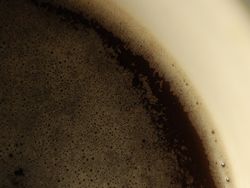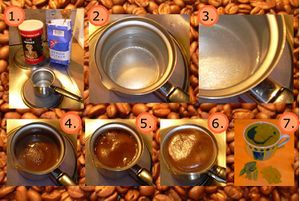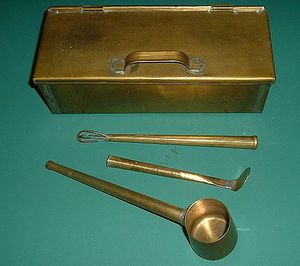قهوة تركي
القهوة التركي Turkish coffee، هي طريقة لتحضير القهوة. يتم غلي حبوب البن المحمصة المطحونة في كنكة، وعادة ما تكون بدون سكر، وتقدم في فنجان ذو يد يستقر في قعره حتل القهوة، وتحته صحن صغير. هذه الطريقة لتحضير القهوة توجد في الشرق الأوسط، شمال أفريقيا، القوقاز، البلقان، بالي، وأماكن مختلفة في شرق اوروپا.
تطورت ثقافة المقاهي بشكل كبير في العالم العثماني، وكان هذا هو النمط السائد لتحضير القهوة.
التاريخ
أصل حبوب البن من إثيوپيا واليمن. في أواخر القرن 15 وأوائل القرن 16، انتشرت في القاهرة ومكة.[1][2]
في حديث المؤرخ العثماني ابراهيم پيچوي عن افتتاح أول مقهى في إسطنبول، يقول:
هناك أساطير مختلفة عن طرحها في "كيڤا هان" عام 1475 مذكورة في مواقع الوب، لكنها غير موثقة.[4]
أثرت القهوة على الثقافة التركية، ولذا فكلمة الإفطار بالتركيةkahvaltı تعني حرفياً "قبل القهوة" (kahve تعني "قهوة" وaltı "قبل"). في العصور الحديثة، أصبحت القهوة التركية أقل شعبية عن الشاي (والذي يزرع محلياً، ويمكن شراؤه بدون عملة صعبة)، القهوة سريعة الذوبان، والأنواع الحديثة الأخرى من القهوة. في الوقت نفسه، تقدم القهوة في سلاسل مقاهي عالمية مثل ساربكس، ومقاهي گلوريا جين في فروعها الموجودة بتركيا، بالرغم من أنها لا تزال متاحة، إلا أنها ليست مشروباً رائجاً.
التسمية والمتغيرات
في الشرق الأوسط، لا يزال يطلق على القهوة التركية في اللغة المحلية، "القهوة".
في اللغة التركية كلمة قهوة "kahve" كانت تطلق على القهوة التركية حتى طرحت القهوة سريعة الذوبان في الثمانينات. اليوم، تطلق أجيال الشباب عليها اسم Türk kahvesi (القهوة التركية).
كلمة مقهى، ولكن المصطلح الأكثر انتشاراً بالعامية هو "قهوة"، وهي المكان الذي تقدم فيه القهوة، والمشروبات الأخرى.
في الكثير من اللغات، مصطلح قهوة "تركية" يستبدل باسم محلي مختلف. على سبيل المثال "القهوة الأرمنية. (Հայկական սուրճ haykakan surj)، "القهوة اليونانية" (ελληνικός καφές ellinikós kafés)، و"القهوة القبرصية" (κυπριακός καφές kypriakós kafés)، أو تسقط تماماً.[بحاجة لمصدر]. لا تزال كلمة "قهوة" و"مقهى" كما هي لم تتغير في اليونانية وكذلك في لغات البلقان الأخرى، وتستخدم الكلمات التركية العثمانية kahve وkahvehane: بالبلغارية кафе، кафене؛ بالمقدونية السلاڤية кафе, Serbian kafa, kafana; بالكرواتية kava, kavana; بالبوسنية kahva, kafana; بالسلوڤينية kava, kavarna; بالرومانية cafea, cafenea; باليونانية καφές, καφενείο; بالألبانية kafe, kafene.
العالم العربي
في العالم العربي، تطلق القهوة "التركية" على معظم أنواع القهوة. ويطلق عليها الشامية أو القهوة العربية، وقد تعلم الأتراك طريقة تحضيرها من العرب في بلاد الشمس. الأنواع الغربية معروفة أيضاً وعادة ما تسمى "نسكافيه" وهو اسم العلامة التجارية الشهيرة.[بحاجة لمصدر]. في بعض الأحيان فقط يشير العرب للقهوة التركية نسبة لبلدهم الأصلي، مثل "القهوة المصرية"، "القهوة اللبنانية"، "القهوة العراقية"، وقد يرجع ذلك لاختلاف النكهة، التحضير، أو التقديم، عن القهوة التركية؛ على سبيل المثال، يستخدم المصريون مصطلح "القهوة العربية" لتمييزها عن "القهوة المصرية" للتمييز بين الطريقة المصرية لتقديم القهوة التركية عن الطريقة العربية.
أرمنيا
في أرمنيا، يطلق على القهوة التركية اسمՍուրճ (sourj 'قهوة') أوՀայկական Սուրճ (haykakan sourj 'القهوة الأرمنية'). وعادة ما تقدم بسكر معتدل (sovorakan/طبيعي)، حلوة،(kaghtsr) أو بدون سكر (daruh).
البوسنة والهرسك
في البوسنة والهرسك، يطلق على القهوة التركية القهوة البوسنية، وتصنع بطريقة تختلف قليلاً عن الطريقة التركية. وعادة ما تصنع القهوة التركية بأسماء تجارية بوسنية (وتشمل Zlatna Dzezva, Minas، وSaraj Kafa). شرب القهوة في البوسنة هي عادة يومية تقليدية وتلعب دوراً هاماً في المجتمع، وخاصة أثناء التجمعات الاجتماعية.
كرواتيا
في كرواتيا، يطلق عليها turska kava، أي "القهوة التركية". أو تعرف اختصاراً بالقهوة kava، عدا في المقاهي، لعدم الخلط بينها وبين الأنواع الأخرى من القهوة.
ألبانيا
في ألبانيا، تعرف القهوة التركية باسم ( Kafe Turke ) وهي مشروب شائع جداً بالرغم من أنها فقدت شعبيتها في الأونة الأخيرة بين الشباب الذين يفضلون شرب قهوة الإسپرسو الإيطالية. تعتبر القهوة عنصراً أساسياً في المشهد الاجتماعي الألباني.
اليونان وقبرص
في اليونان وقبرص، طرح هذا التغير مع دخول صناعة البن بعد الغزو التركي لقبرص عام 1974.
...بعد وصول الأتراك قبرص في يوليو 1974، عندما أصبحت العلاقات التركية القبرصية متوترة على جميع المستويات، τούρκικος καφές أصبحت ελληνικός καφές بعد أن استبدلت الكلمة القبرصية بالتركية، ولا يوجد ما يكافئها باليونانية، ولذا لم تتغير.[5]
إسرائيل
بالعبرية تسمى kafe turki (קפה טורקי) وتعني ببساطة "القهوة التركية" حيث تحضر القهوة بصب الماء الغلي على حبوب البن (بدون طهي)، تعرف باسم (kafe) botz (קפה בוץ)، أي "mud coffee".
مقدونيا
في جمهورية مقدونيا، هذا النوع من القهوة يسوق باسم "القهوة المقدونية" (Македонско кафе) وكذلك بالاسم الشائع "القهوة التركية" (Турско кафе). من أيام الدولة العثمانية حتى اليوم، لعبت القهوة دوراً هاماً في أسلوب الحياة والثقافة المقدونية. تقديم واستهلاك القهوة كان له تأثير عميق على تقاليد الخطبة والنوع، التفاعل السياسي والاجتماعي، الصلاة، تقاليد الضيافة. بالرغم من أن العديد من الطقوس ليست سائدة في المجتمع المعاصر، فلا تزال القهوة جزءاً لا يتجزأ من الثقافة المقدونية.
الصرب
في التجمعات الصربية، يطلق على القهوة domaća kafa 'القهوة المحلية' أو القهوة' القهوة وخاصة القهوة القوية (بدون سكر أو لبن) عادة ما تسمى القهوة التركية أو القهوة الداكنة.
الأدوات
Turkish coffee is normally prepared using a narrow-topped small boiling pot called an kanaka, cezve, džezva, xhezve or μπρίκι (bríki) (basically a tiny ewer), a teaspoon and a heating apparatus. The ingredients are finely ground coffee, sometimes cardamom, cold water and (if desired) sugar. It is served in a demitasse (fincan, fildžan,filxhan or φλιτζάνι (flidzáni)). Some modern cups do have handles; traditional cups did not, and coffee was drunk either by handling the cup with the fingertips or, more often, by placing the cup in a zarf, a metal container with a handle.
Traditionally, the pot is made of copper and has a wooden handle, although other metals such as aluminium with a non-stick coating are also used. The size of the pot is chosen to be close to the total volume of the cups to be prepared, since using too large a pot causes much of the foam to stick to the inside of it. The teaspoon is used both for stirring and measuring the amount of coffee and sugar. The teaspoons in some other countries are much larger than the teaspoons in countries where Turkish coffee is common: The dipping parts of the teaspoons in these countries are about 1 cm (0 in) long and 0.5 cm (0 in) wide.
A moderately low heat is used so that the coffee does not come to the boil too quickly—the beans need to be in hot water for long enough to extract the flavour. In a modern setting normal gas or electric heating is satisfactory. Traditional heating sources include the embers of a fire, or a tray about 10 cm (4 in) deep filled with sand. The tray is placed on the burner. When the sand is hot, the coffee pot is placed in the sand.[بحاجة لمصدر] This allows a more even and gentle heat transfer than direct heat.
التحضير
 |
| هذا المقال جزء من سلسلة عن |
| المطبخ التركي Türk mutfağı |
|---|
|
|
There is no special kind of coffee bean; Turkish coffee is a method of preparation, not a kind of coffee. Beans for Turkish coffee are ground or pounded to the finest possible powder, finer than for any other way of preparation. The grinding is done either by pounding in a mortar (the original method) or using a burr mill. Most domestic coffee mills are unable to grind finely enough; traditional Turkish hand grinders are an exception.
The best Turkish coffee (or any kind of coffee) is made from freshly roasted beans ground just before brewing, but Turkish-ground coffee can be bought and stored as any other type, losing flavour with time.
While there are variations in detail, preparation of Turkish coffee, like all types of coffee, essentially consists of immersing the coffee grounds in water which is most of the time hot but not boiling for long enough to dissolve the flavoursome compounds. While prolonged boiling of coffee gives it an unpleasant "cooked" or "burnt" taste, very brief boiling does not, and bringing it to the boil shows without guesswork that it has reached the appropriate temperature.
The amount of cold water necessary can be measured using the cups. The coffee and the sugar are usually added to water, rather than being put into the pot first, although this is not essential—an article in Scientific American for November 1977 found that there were advantages to putting the coffee in first, then covering it with sugar and adding water without stirring. For each cup, between one and two heaped teaspoons of coffee are used. In Turkey, four degrees of sweetness are used. The Turkish terms and approximate amounts are as follows: sade (plain; no sugar), az şekerli (little sugar; half a level teaspoon of sugar), orta şekerli (medium sugar; one level teaspoon), and çok şekerli (a lot of sugar; one and a half or two level teaspoons). In the Arab World "sāda" (سادة plain; no sugar, meaning "black" in Arabic) or "murra" ( مرة bitter; no sugar) is common. The coffee and the desired amount of sugar are stirred until all coffee sinks and the sugar is dissolved. Following this, the spoon is removed and the pot is put on moderate heat; if too high, the coffee comes to the boil too quickly, without time to extract the flavour. No stirring is done beyond this point, as it would dissolve the foam. Just as the coffee comes to the boil the pot is removed from the heat. It is usually kept off the heat for a short time, then brought to the boil a second and a third time, then the coffee is poured into the cups. Getting the thickest possible layer of foam is considered the peak of the coffee maker's art. One way to maximise this is to pour slowly and try to lift the pot higher and higher as the pouring continues. Regardless of these techniques, getting the same amount of foam into all cups is hard to achieve, and the cup with the most foam is considered the best of the lot.
A well-prepared Turkish coffee has a thick foam at the top (köpük in Turkish), is homogeneous, and does not contain noticeable particles in the foam or the liquid. It is possible to wait an additional twenty seconds past boiling to extract a little more flavour, but the foam is completely lost. To overcome this, foam can be removed and put into cups earlier and the rest can be left to boil. In this case special attention must be paid to transfer only the foam and not the suspended particles.
There are other schools of preparing Turkish coffee that vary from the above. Lebanese coffee starts with hot water alone, to which sugar is added and dissolved. The product is in essence a sugar syrup with a higher boiling point than water. The coffee, and cardamom if wanted, are added, and the mixture is stirred. It is then brought to a boil two or three times; the double (or triple) boiling is an essential part of the process, both ceremonially and—as connoisseurs claim—for the palate. It has the effect of subjecting the coffee grounds to hot (but not boiling) water for longer, extracting more flavour without imparting the "cooked" taste of over-boiled coffee.
In the Balkans, dominant practice is to fill the džezva with only cold water, and heat it till it boils. As the water boils coffee is added, stirred, and removed from the fire before the foam boils over. After the foam settles the pot is placed back onto the heat source so the water would boil again, releasing more caffeine and flavour. Sometimes the last step is skipped, to preserve the foam. This type of preparation is known as Bosnian coffee or Serbian coffee.
الشرب
Turkish coffee is taken at extremely hot temperatures and is usually served with a glass of cold water to freshen the mouth to better taste the coffee. It is traditionally served with Turkish delight. In the Mediterranean and southeastern Turkey, pistachio grains (kakuli/menengiç) may be added into the coffee. All of the coffee in the pot is poured into cups, but not all of it is drunk. The thick layer of sludgy grounds at the bottom of the cup is left behind.
قراءة الفنجان
The grounds left after drinking Turkish coffee can also be used for fortune-telling. The cup is commonly turned over into the saucer to cool, and then the patterns of the coffee grounds can be used for a kind of fortune telling called tasseography (تركية: kahve falı, باليونانية: καφεμαντεία, kafemanteia), or tasseomancy.
قائمة التراث العالمي
في 5 ديسمبر 2013 أعلنت اليونسكو إدراج القهوة التركية على قائمة التراث العالمي غير المادي، واختيارها من بين عدد كبير من عناصر ثقافيّة موروثة قدّمت من قبل عدد من الدول، خلال اجتماع المنظمة المنعقد في العاصمة الأذربيجانية باكو.[6]
الهوامش
- ^ Bonnie K. Bealer, Bennett Alan Weinberg, The World of Caffeine: The Science and Culture of the World's Most Popular Drug, Routledge 2001, p.11. ISBN 0415927226.
- ^ Alain Huetz de Lemps, "Colonial Beverages and the Consumption of Sugar" in Massimo Montanari, Jean Louis Flandrin, ed. Food: A Culinary History, p. 387
- ^ Quoted in Cemal Kafadar, "A History of Coffee", Economic History Congress XIII (Buenos Aires, 2002) full text
- ^ [1]
- ^ Robert Browning, Medieval and Modern Greek, 1983. ISBN 0521299780. p. 16
- ^ "«القهوة التركية» تدخل قائمة «يونسكو» للتراث العالمي". جريدة الحياة اللبنانية. 2013-12-05. Retrieved 2013-12-05.
وصلات خارجية
- Articles with unsourced statements from July 2009
- Articles with unsourced statements from August 2008
- Articles containing explicitly cited عربية-language text
- Articles with hatnote templates targeting a nonexistent page
- Pages using Lang-xx templates
- Articles containing Greek-language text
- قهوة
- تحضير القهوة
- مطبخ ألباني
- مطبخ عربي
- مطبخ أرمني
- مطبخ البوسنة والهرسك
- مطبخ يوناني
- مطبخ مقدوني
- مطبخ قبرصي
- مطبخ كرواتي
- مطبخ صربي
- مطبخ شامي
- مطبخ قبرصي تركي




